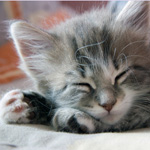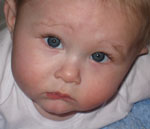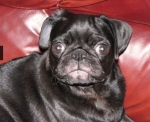AHI and RDI
- NeedSomeAir
- Posts: 24
- Joined: Mon Sep 07, 2009 2:47 pm
- Location: Texas, USA
AHI and RDI
I was diagnosed with severe sleep apnea. During my sleep study, my AHI was 17.0. But my REM AHI was 72.7 and REM RDI was 77.3.
So does the high REM AHI numbers mean I have severe sleep apnea or is it just the initial AHI, or both?
And what is RDI?
Thanks,
NSA
So does the high REM AHI numbers mean I have severe sleep apnea or is it just the initial AHI, or both?
And what is RDI?
Thanks,
NSA
_________________
| Mask: Ultra Mirage™ Full Face CPAP Mask with Headgear |
| Additional Comments: You can call me NSA for short! :) |
Re: AHI and RDI
It means that when you sleep into the Rapid Eye Movement stage of sleep, you choke more than once a minute. Which would probable make your oxygen saturation plummet for that part of the night.
O.
O.
_________________
| Mask: AirFit™ P10 Nasal Pillow CPAP Mask with Headgear |
| Additional Comments: Machine: Resmed AirSense10 for Her with Climateline heated hose ; alternating masks. |
And now here is my secret, a very simple secret; it is only with the heart that one can see rightly, what is essential is invisible to the eye.
Antoine de Saint-Exupery
Good advice is compromised by missing data
Forum member Dog Slobber Nov. 2023
Antoine de Saint-Exupery
Good advice is compromised by missing data
Forum member Dog Slobber Nov. 2023
Re: AHI and RDI
NSA,NeedSomeAir wrote:I was diagnosed with severe sleep apnea. During my sleep study, my AHI was 17.0. But my REM AHI was 72.7 and REM RDI was 77.3.
So does the high REM AHI numbers mean I have severe sleep apnea or is it just the initial AHI, or both?
And what is RDI?
Thanks,
NSA
Not sure I understand what you are asking (could be my cloudy brain), but I will take a whack at it. However, I will warn you that there are far smarter people here than me.
The REM AHI number represents the number of Apneas (A) and Hypopneas (H) that occur in an hour during the REM stage of sleep. An AHI of 17 is slightly higher than mild. RDI is defined as Respiratory Disturbance Index and it combines the AHI with RERA's to yield a score, which no one seems to have the rating scale for. In fact, if you find it let me know. Unfortunately, many folks believe that AHI and RDI are the same unit of measure using the same scale, but they are NOT the same.
Re: AHI and RDI
Numbers have two general purposes: Purpose number one is to make a diagnosis that implies you could benefit from therapy. Purpose number two is to figure out how your therapy is going so you can figure out if there are ways to improve it.
To me, that means: Don't get too obsessed with numbers. You need to know what your diagnosis is and why, so sure, seeing the numbers from diagnostic and titration studies can help with that. And, yeah, you need efficacy data to have a starting point from which you can change things to improve treatment. But the scales themselves are imperfect and of more use to the insurance people as far as placing people into categories. What is the scale for "sleepy"? Epworth is a way of putting a number to a subjective judgment, but that's about it. Yet how sleepy and tired you are when you wake up in the morning and as you go through the day is very important and you may choose to make your own scale for that, if you want to track it. That would likely be more useful information to you than worrying about arousals that can only be tracked in a sleep study anyway and what category that puts you in compared to someone else.
That is my personal view. It may be nonstandard.
jeff
To me, that means: Don't get too obsessed with numbers. You need to know what your diagnosis is and why, so sure, seeing the numbers from diagnostic and titration studies can help with that. And, yeah, you need efficacy data to have a starting point from which you can change things to improve treatment. But the scales themselves are imperfect and of more use to the insurance people as far as placing people into categories. What is the scale for "sleepy"? Epworth is a way of putting a number to a subjective judgment, but that's about it. Yet how sleepy and tired you are when you wake up in the morning and as you go through the day is very important and you may choose to make your own scale for that, if you want to track it. That would likely be more useful information to you than worrying about arousals that can only be tracked in a sleep study anyway and what category that puts you in compared to someone else.
That is my personal view. It may be nonstandard.
jeff
Re: AHI and RDI
http://www.aasmnet.org/Resources/Clinic ... Adults.pdf
Clinical Guideline for the Evaluation, Management and Long-term Care of Obstructive Sleep Apnea in Adults
Adult Obstructive Sleep Apnea Task Force of the American Academy of Sleep Medicine
Clinical Guideline for the Evaluation, Management and Long-term Care of Obstructive Sleep Apnea in Adults
Adult Obstructive Sleep Apnea Task Force of the American Academy of Sleep Medicine
The diagnosis of OSA is confirmed if the number of obstructive
events (apneas, hypopneas + respiratory event related
arousals) on PSG is greater than 15 events/hr or greater than 5/
hour in a patient who reports any of the following: unintentional
sleep episodes during wakefulness; daytime sleepiness; unrefreshing
sleep; fatigue; insomnia; waking up breath holding,
gasping, or choking; or the bed partner describing loud snoring,
breathing interruptions, or both during the patient’s sleep.1 OSA
severity is defined as mild for RDI ≥ 5 and < 15, moderate for
RDI ≥ 15 and ≤ 30, and severe for RDI > 30/hr (Consensus).
_________________
| Mask: AirFit™ P10 Nasal Pillow CPAP Mask with Headgear |
| Additional Comments: Machine: Resmed AirSense10 for Her with Climateline heated hose ; alternating masks. |
And now here is my secret, a very simple secret; it is only with the heart that one can see rightly, what is essential is invisible to the eye.
Antoine de Saint-Exupery
Good advice is compromised by missing data
Forum member Dog Slobber Nov. 2023
Antoine de Saint-Exupery
Good advice is compromised by missing data
Forum member Dog Slobber Nov. 2023
- NeedSomeAir
- Posts: 24
- Joined: Mon Sep 07, 2009 2:47 pm
- Location: Texas, USA
Re: AHI and RDI
I understand they are just numbers, I am just trying to understand my situation. My AHI is moderate yet I would think that a REM 72.7 is pretty severe since REM sleep is more important than deep sleep (at least that is what the specialists tell me).
Before the cpap my mouth and airway were incredibly dry with my throat walls sticking together. I couldn't sleep on my stomach. I would wake up several times a night, soooo many times a night it was ridiculous. I would get incredibly sleepy during the day and most days would be sleeping day and night but not being satisfied. But the last couple of nights I have been waking up perhaps only 2-3 times a night and getting up once, which is great. I do feel better but I still get sleepy during the day. The naps I have had daily so far have been only an hour at a time (around 2 times a day). But I've only used the cpap machine for two nights so far.
I couldn't breathe before the cpap and now with using it I can take deep breaths! But the AHI says I am moderate? I don't understand that. But you are right, they are just numbers.
Just a curiosity I guess. Don't know why I was diagnosed with severe sleep apnea. I got a really good machine I think. The mask is comfortable for what it is (not that I'd wear it out on a date ).
Before the cpap my mouth and airway were incredibly dry with my throat walls sticking together. I couldn't sleep on my stomach. I would wake up several times a night, soooo many times a night it was ridiculous. I would get incredibly sleepy during the day and most days would be sleeping day and night but not being satisfied. But the last couple of nights I have been waking up perhaps only 2-3 times a night and getting up once, which is great. I do feel better but I still get sleepy during the day. The naps I have had daily so far have been only an hour at a time (around 2 times a day). But I've only used the cpap machine for two nights so far.
I couldn't breathe before the cpap and now with using it I can take deep breaths! But the AHI says I am moderate? I don't understand that. But you are right, they are just numbers.
Just a curiosity I guess. Don't know why I was diagnosed with severe sleep apnea. I got a really good machine I think. The mask is comfortable for what it is (not that I'd wear it out on a date ).
_________________
| Mask: Ultra Mirage™ Full Face CPAP Mask with Headgear |
| Additional Comments: You can call me NSA for short! :) |
- NeedSomeAir
- Posts: 24
- Joined: Mon Sep 07, 2009 2:47 pm
- Location: Texas, USA
Re: AHI and RDI
I was reading the results again and it says diagnosis was "OSA (severe in REM, with O2desat)". So I guess that is why it was diagnosed as severe. No biggie I know. Just a curiosity. Thanks folks.
_________________
| Mask: Ultra Mirage™ Full Face CPAP Mask with Headgear |
| Additional Comments: You can call me NSA for short! :) |
Re: AHI and RDI
Your diagnosis is very similar to mine. We are worse in REM stage sleep. This is really quite common.
These words "severe", "moderate" or even "mild" are just words because someone has to have some sort of line to go by. I was "mild" with 11 AHI in non REM sleep if you just go by the AHI numbers but I had some 40 second events and my O2 went down to 73% so that makes me pretty diagnostic right there. Then I get to REM stage sleep and I have 53 AHI.
The pressure needed to maintain an open airway is relative to our physical makeup and not the level of severity of the OSA diagnosis. A person with a very "mild" diagnosis can easily need a high pressure and someone with "severe" could easily only need a minimal pressure. So the pressure requirement is unrelated to severity of the OSA diagnosis.
REM sleep is important but also Stage 3 sleep is important. Both these stages give our bodies much needed restorative powers. The whole sleep picture is important. I have a pretty good handle on the mask and machine part of this stuff but I have some issues with still having very fragmented sleep which affects all the different stages of sleep, which boils down to not always feeling like I have had the best of nights despite "good" numbers.
You have a great machine and if you wish to go the software route, I have the same type of machine and software and I can answer questions about it. Just drop me a private message if you wish.
These words "severe", "moderate" or even "mild" are just words because someone has to have some sort of line to go by. I was "mild" with 11 AHI in non REM sleep if you just go by the AHI numbers but I had some 40 second events and my O2 went down to 73% so that makes me pretty diagnostic right there. Then I get to REM stage sleep and I have 53 AHI.
The pressure needed to maintain an open airway is relative to our physical makeup and not the level of severity of the OSA diagnosis. A person with a very "mild" diagnosis can easily need a high pressure and someone with "severe" could easily only need a minimal pressure. So the pressure requirement is unrelated to severity of the OSA diagnosis.
REM sleep is important but also Stage 3 sleep is important. Both these stages give our bodies much needed restorative powers. The whole sleep picture is important. I have a pretty good handle on the mask and machine part of this stuff but I have some issues with still having very fragmented sleep which affects all the different stages of sleep, which boils down to not always feeling like I have had the best of nights despite "good" numbers.
You have a great machine and if you wish to go the software route, I have the same type of machine and software and I can answer questions about it. Just drop me a private message if you wish.
_________________
| Machine: AirCurve™ 10 VAuto BiLevel Machine with HumidAir™ Heated Humidifier |
| Additional Comments: Mask Bleep Eclipse https://bleepsleep.com/the-eclipse/ |
I may have to RISE but I refuse to SHINE.
Re: AHI and RDI
Sounds to me like you are doing great. And that was a great question.
I wonder if it is newet trend for docs/labs to use "REM AHI" as a way to meet the diagnostic criteria instead of all-night AHI? Or is that something that has been going on for a while? Or is that the sort of question no one is supposed to ask out loud?
I wonder if it is newet trend for docs/labs to use "REM AHI" as a way to meet the diagnostic criteria instead of all-night AHI? Or is that something that has been going on for a while? Or is that the sort of question no one is supposed to ask out loud?
Re: AHI and RDI
For those keeping score at home, the aforementioned scale assumes that AHI and RDI are the same. They are NOT. In reality, the scale is used more commonly when referring to AHI. Apparently a true scale for RDI, scoring RERA's as well as AHI doesn't exist. Bottom line here, use your NREM AHI numbers when comparing your value to this scale, NOT your RDI. Using your RDI (if you have high RERA's) could place you in another galaxy.ozij wrote:http://www.aasmnet.org/Resources/Clinic ... Adults.pdf
Clinical Guideline for the Evaluation, Management and Long-term Care of Obstructive Sleep Apnea in Adults
Adult Obstructive Sleep Apnea Task Force of the American Academy of Sleep Medicine
The diagnosis of OSA is confirmed if the number of obstructive
events (apneas, hypopneas + respiratory event related
arousals) on PSG is greater than 15 events/hr or greater than 5/
hour in a patient who reports any of the following: unintentional
sleep episodes during wakefulness; daytime sleepiness; unrefreshing
sleep; fatigue; insomnia; waking up breath holding,
gasping, or choking; or the bed partner describing loud snoring,
breathing interruptions, or both during the patient’s sleep.1 OSA
severity is defined as mild for RDI ≥ 5 and < 15, moderate for
RDI ≥ 15 and ≤ 30, and severe for RDI > 30/hr (Consensus).
Ace
-
ozij (away from home)
Re: AHI and RDI
lazyace wrote:Using your RDI (if you have high RERA's) could place you in another galaxy.
For some reason Ace (!) assumes he know better than the American Academy of Sleep Medicine.
Having decided not to accept their definition, he now says the kind of definition he is searching for does not exist.
For those of us who are mere mortals and exist on planet earth, and accept the AASM definition, RDI includes RERA's, and even if you have no apneas or hypopneas, and only have RERA's you may be diagnosed with obstructive sleep apnea. But that of course is on planet earth.
Clinical Guideline for the Evaluation, Management and Long-term Care of Obstructive Sleep Apnea in Adults
Adult Obstructive Sleep Apnea Task Force of the American Academy of Sleep Medicine
The diagnosis of OSA is confirmed if the number of obstructive
events (apneas, hypopneas + respiratory event related
arousals) on PSG is greater than 15 events/hr or greater than 5/
hour in a patient who reports any of the following: unintentional
sleep episodes during wakefulness; daytime sleepiness; unrefreshing
sleep; fatigue; insomnia; waking up breath holding,
gasping, or choking; or the bed partner describing loud snoring,
breathing interruptions, or both during the patient’s sleep.1 OSA
severity is defined as mild for RDI ≥ 5 and < 15, moderate for
RDI ≥ 15 and ≤ 30, and severe for RDI > 30/hr (Consensus).
What's In A Name?
"IMHO", because that is the way Ace thinks (reaching a premature conclusion based on insufficient and/or incorrect information, and then offhandedly dismissing concepts that do not fit his template), he will never find a solution to his issues.ozij (away from home) wrote:For some reason Ace (!) assumes he know better than the American Academy of Sleep Medicine.
Having decided not to accept their definition, he now says the kind of definition he is searching for does not exist.
Begging everyone's pardon, I hope I'm not offending anyone, apologizing in advance, with all due respect, and the only reason Foghat is good now is because the only guy left from the original band is the guy on skins, it may be helpful to understand the differences between AHI and RDI by examining the untoward sequelae that result from SDB. There are basically 3 things in SBD that generate problems:
Breathing against an obstructed/restricted airway and desaturations. These will be responsible for cardiovascular consequences such as risk of stroke, hypertension, cardiac issues, and the like; and
Disturbances in sleep continuity. With rare exception (noted elsewhere, and it's almost academic anyway) apneas and hypopneas will have concomitant arousal, and RERAs, by definition, all need an arousal. It is the disturbances in sleep continuity that generate EDS.
Now, while we can easily argue that since RERAs also need some altered breathing to occur (flattened respiratory waveform PLUS increased breathing effort noted in some other measure) that they, too, can have cardiovascular consequences, perhaps that is a discussion better left to the academicians.
What makes the search for RERA so difficult in looking at single-channel data is that flattened waveforms from an xPAP-generated breath are a common if not usual phenomenon in that the machine-generated breath itself is flow-variable (the "flatness' could be just as easily be a result of the machine as the patient).
At the least, RDI is more reflective of sleep itself, but the use of RDI is mostly a result of insurance issues rather than clinical criteria.
Muffy
________________________________
Machine: Dell Dimension 8100
Mask: 3M N-95 (during flu season)
Humidifier: Avoided, tends to make me moldy
Software: XP Pro
Additional Comments: You can't find a solution when you don't know the problem
Machine: Dell Dimension 8100
Mask: 3M N-95 (during flu season)
Humidifier: Avoided, tends to make me moldy
Software: XP Pro
Additional Comments: You can't find a solution when you don't know the problem
Re: AHI and RDI
Got a question. Have I got this right? The RDI is your AHI + REFAs (respiratory-related arousals, shifts in sleep stages determined in a PSG). Does the RDI include the spontaneous arousals (SA Index) which by definition are not respiratory? So, to consider our overall quality of sleep during the PSG, we should:
Is fragmented sleep (which is exhausting) treated with CPAP therapy or via some other route? Or, is it first treated with CPAP therapy to attempt to stablize sleep architecture and then re-evaluate as needed based on our experience?
- Review apneas, centrals, and hypops for events that affect our breathing during sleep
- Review our EEG tracings to see how often our brain panicked and to what during the PSG
- Review SpO2 for how low our oxygen levels went while sleeping (pulse rates too for highs and lows)
- Review respiratory and spontaneous arousals as they show shifts in sleep stages
- Review sleep architecture (%s in Stages & REM) for fragmented sleep
- Look for any detected leg movements, EEG abnormal findings or comments, or detected cardiac effects/comments
Is fragmented sleep (which is exhausting) treated with CPAP therapy or via some other route? Or, is it first treated with CPAP therapy to attempt to stablize sleep architecture and then re-evaluate as needed based on our experience?
ResMed S9 range 9.8-17, RespCare Hybrid FFM
Never, never, never, never say never.
Never, never, never, never say never.
Re: AHI and RDI
Perhaps O hasn't paid much attention to my posts, or simply doesn't comprehend the point I have been trying to make!!!! RDI and AHI are sometimes used as synonyms, you know like the same. However, the reality is they are NOT, you know like the same thing only different. YOU CANNOT USE THE SAME SCALE FOR RDI AS AHI, BECAUSE THEY ARE NOT MEASURING THE SAME METRICS. The term AHI is much more widely used, but only looks at two criteria for scoring events. However, RDI looks at both items used to score AHI, along with RERA's. That is why a patients PSG may have a value for AHI and ANOTHER value for RDI. Unfortunately, the sleep industry is far from making any kind of consensus. Besides, as many of us are learning, the scoring systems for both are arbitrary at best.ozij (away from home) wrote:lazyace wrote:Using your RDI (if you have high RERA's) could place you in another galaxy.
For some reason Ace (!) assumes he know better than the American Academy of Sleep Medicine.
Having decided not to accept their definition, he now says the kind of definition he is searching for does not exist.
For those of us who are mere mortals and exist on planet earth, and accept the AASM definition, RDI includes RERA's, and even if you have no apneas or hypopneas, and only have RERA's you may be diagnosed with obstructive sleep apnea. But that of course is on planet earth.
Clinical Guideline for the Evaluation, Management and Long-term Care of Obstructive Sleep Apnea in Adults
Adult Obstructive Sleep Apnea Task Force of the American Academy of Sleep Medicine
The diagnosis of OSA is confirmed if the number of obstructive
events (apneas, hypopneas + respiratory event related
arousals) on PSG is greater than 15 events/hr or greater than 5/
hour in a patient who reports any of the following: unintentional
sleep episodes during wakefulness; daytime sleepiness; unrefreshing
sleep; fatigue; insomnia; waking up breath holding,
gasping, or choking; or the bed partner describing loud snoring,
breathing interruptions, or both during the patient’s sleep.1 OSA
severity is defined as mild for RDI ≥ 5 and < 15, moderate for
RDI ≥ 15 and ≤ 30, and severe for RDI > 30/hr (Consensus).
Re: What's In A Name?
Muffy wrote:ozij (away from home) wrote:For some reason Ace (!) assumes he know better than the American Academy of Sleep Medicine.
Having decided not to accept their definition, he now says the kind of definition he is searching for does not exist.
"IMHO", because that is the way Ace thinks (reaching a premature conclusion based on insufficient and/or incorrect information, and then offhandedly dismissing concepts that do not fit his template), he will never find a solution to his issues.
Begging everyone's pardon, I hope I'm not offending anyone, apologizing in advance, with all due respect, and the only reason Foghat is good now is because the only guy left from the original band is the guy on skins, it may be helpful to understand the differences between AHI and RDI by examining the untoward sequelae that result from SDB. There are basically 3 things in SBD that generate problems:
Breathing against an obstructed/restricted airway and desaturations. These will be responsible for cardiovascular consequences such as risk of stroke, hypertension, cardiac issues, and the like; and
Disturbances in sleep continuity. With rare exception (noted elsewhere, and it's almost academic anyway) apneas and hypopneas will have concomitant arousal, and RERAs, by definition, all need an arousal. It is the disturbances in sleep continuity that generate EDS.
Now, while we can easily argue that since RERAs also need some altered breathing to occur (flattened respiratory waveform PLUS increased breathing effort noted in some other measure) that they, too, can have cardiovascular consequences, perhaps that is a discussion better left to the academicians.
What makes the search for RERA so difficult in looking at single-channel data is that flattened waveforms from an xPAP-generated breath are a common if not usual phenomenon in that the machine-generated breath itself is flow-variable (the "flatness' could be just as easily be a result of the machine as the patient).
At the least, RDI is more reflective of sleep itself, but the use of RDI is mostly a result of insurance issues rather than clinical criteria.
Muffy
Perhaps Muffy should also pay close attention to the post I just made in response to O. Newbies aren't interested in your long-winded, technical diatribes, when they are simply looking for basic answers. You do a terrific job of highjacking posts and talking in circles. I hope I'm not offending anyone either! The facts are the facts. Period. AHI and RDI are not the same, and neither are the scales used to score them! I would think with all of your knowledge you would know that these terms and scoring mechanisms are all too often used as though they are the same. For those that are trying for the first time to comprehend their PSG report, it is confusing enough without adding terms and scores that sometimes mean the same and sometimes mean something different. Do like I did and spend hours researching the differences between RDI and AHI, and how they are often used synonymously. Perhaps this link will help you! http://meeting.chestjournal.org/cgi/con ... 132/4/464b












